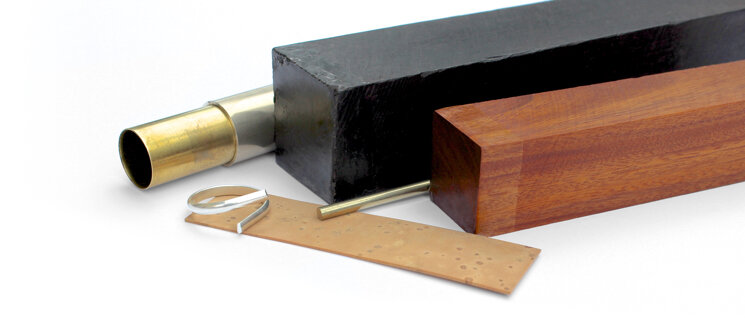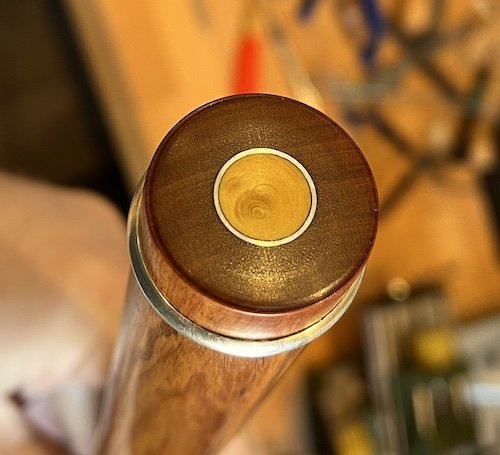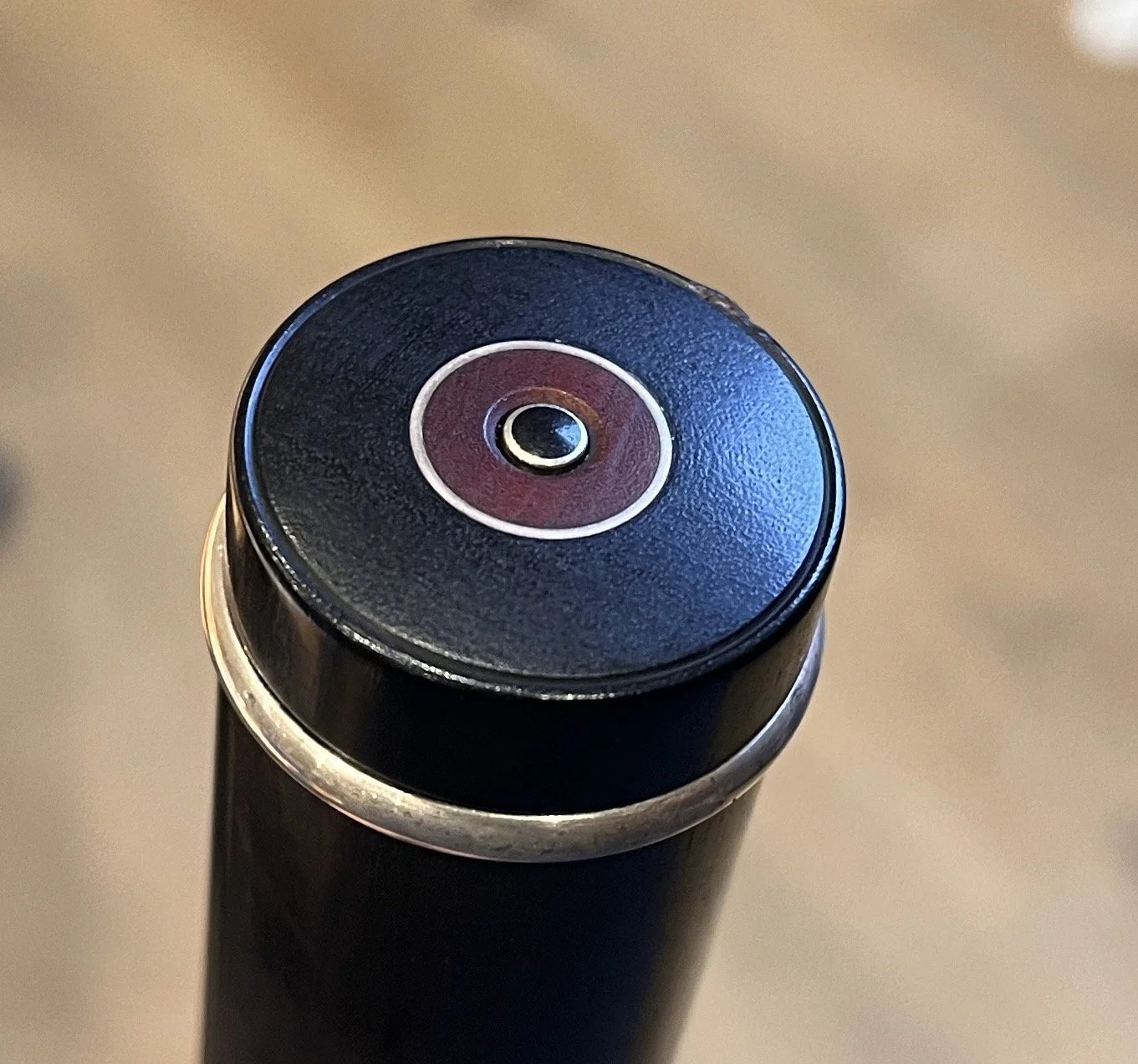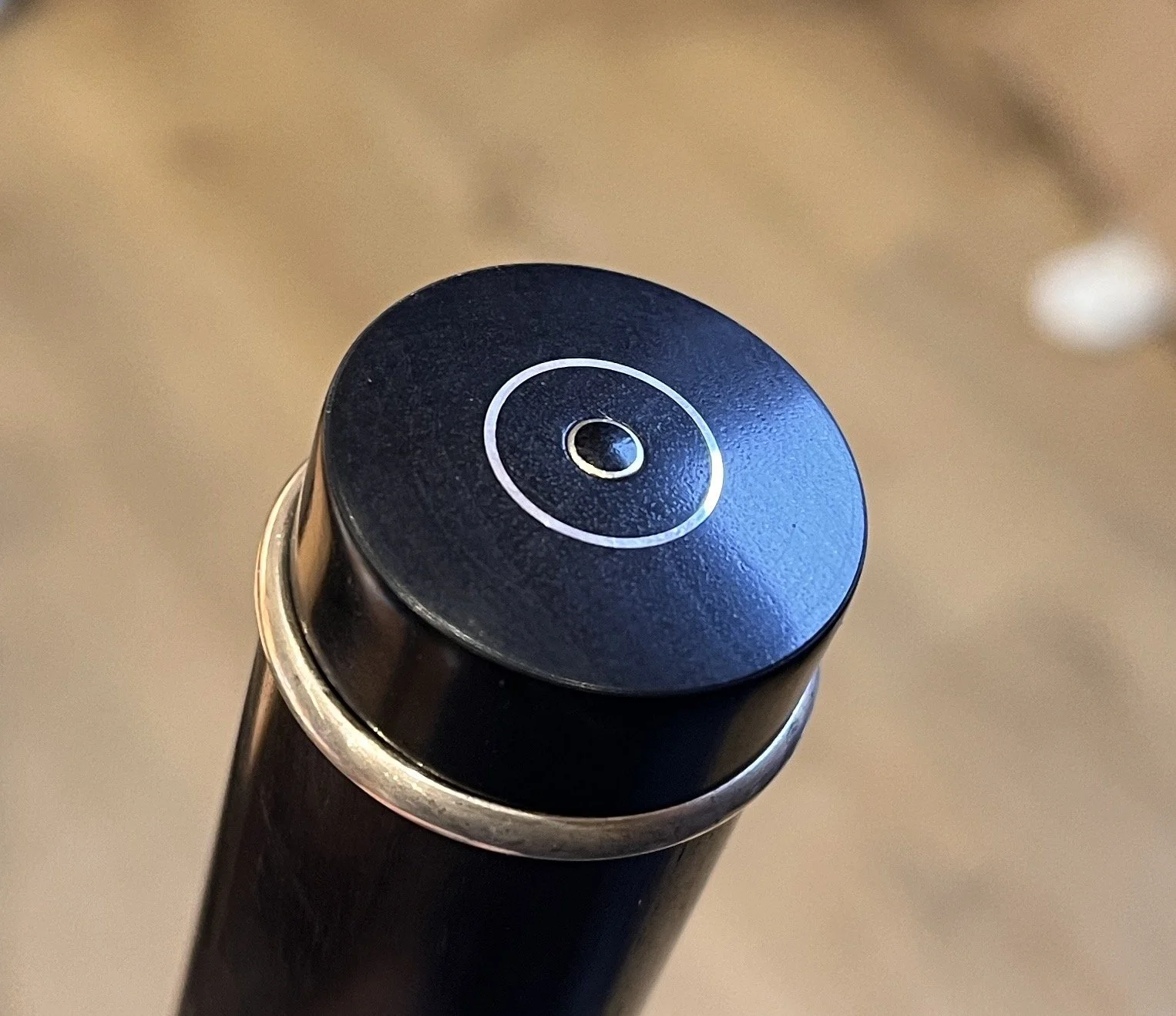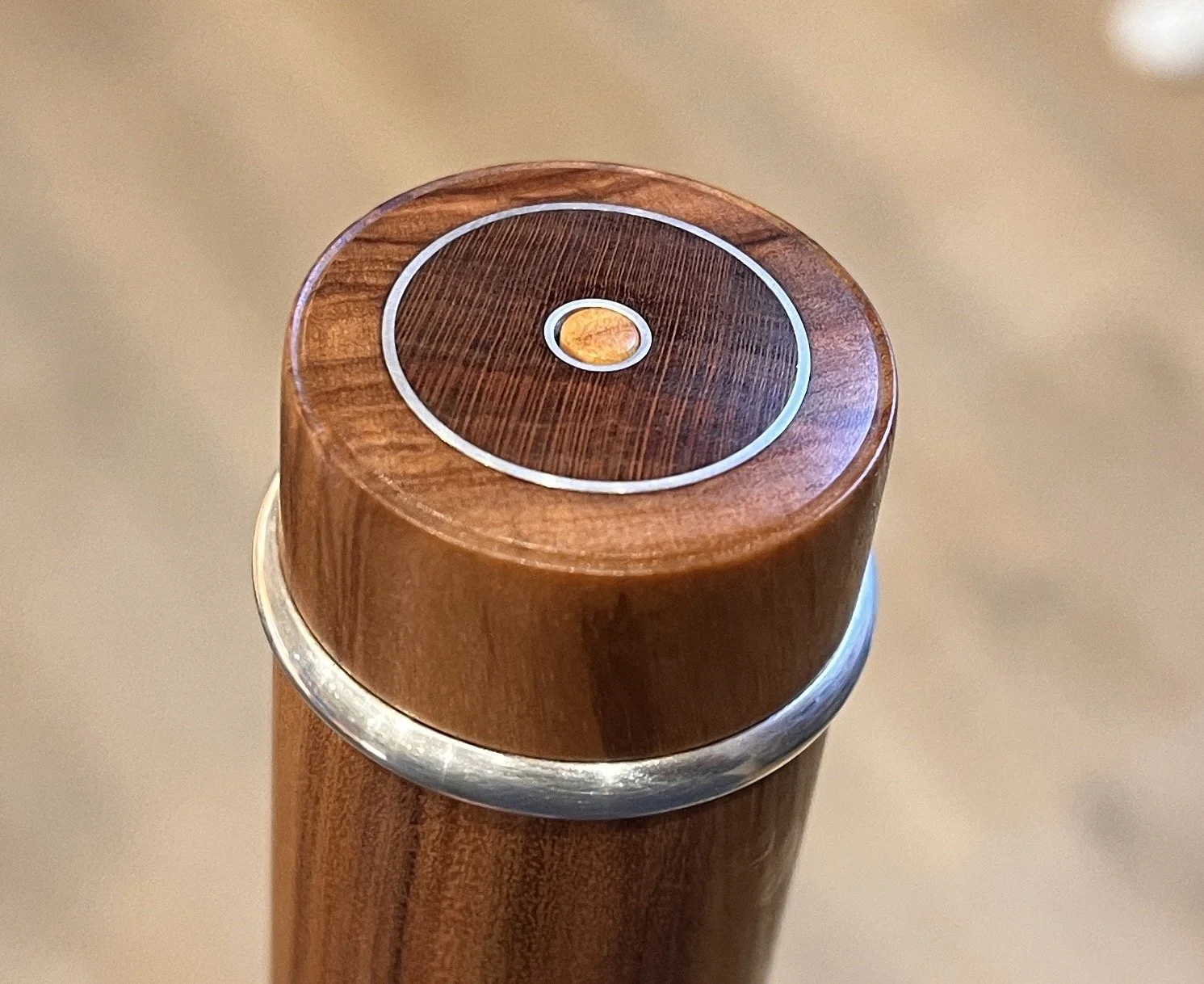
PHILOSOPY
I am Steffen Gabriel, instrument maker and musician. For more than 10 years, I have been building traditional Irish flutes in various tunings and finishes in my workshop near Münster. My aim is to build instruments that are easy to play over the entire range. Their tone has warm lows and bell-like highs - and offers great dynamic and creative possibilities without putting obstacles in the way of the player. Because making music is supposed to be fun and not work!
By the way – impressions from the daily workshop routine, photos, updates and more can be found on my Instagram, YouTube and Facebook pages.
This short documentary (presented by the Lasta Festival in Ireland 2021) offers an insight into my old workshop. I relocated to a much bigger space recently. You’re welcome to visit!
SOUND EXAMPLES
D Flute - 8 keys, Olive Wood, Rudall & Rose Wide Bore.
D Flute - 6 keys, African Blackwood, Rudall & Rose Wide Bore.
D Flute - 8 keys, Mopane. Low C key in action.
D Flute - 8 keys, Mopane, Rudall & Rose Narrow Bore.
Eb Flute - keyless, Olive Wood.
Handmade
Each one of my flutes is unique and is made purely by hand.
HOW I WORK
The production of my flutes is done by hand on various machine tools and with a lot of hand work. The mouth hole is carefully undercut by hand, as are the tone holes. Since the external shaping of the instrument is carried out on the traditional hand lathe, each instrument looks slightly different from all the others, despite unchanged acoustically relevant measurements, and is therefore absolutely unique. Furthermore, this combination of modern, precise machine tool technology and old craftsmanship allows me to respond very extensively to customer wishes regarding the external design of the instrument.
The decorative and reinforcement rings are also handcrafted by me from solid 935 silver without any machine use. This is very costly - but the pure white shine of highly polished hand-forged silver fully compensates for this additional work. I also make the flute keys myself - normally in the traditional style of block mounting, but the modern alternative of pillar mounting (like on clarinets) is also available on special request. Here you can find an overview of the different woods and materials I use for my work:
About me
I made my first experiments in flute making in order to get to know my instrument better - I am a musician myself and I am touring with the flute on stages in Germany and abroad. Out of my curiosity a solid plan finally emerged and at the end of 2008 I started to set up a workshop in the basement on eight square meters …

More topics
Models
Discover different tunings, woods and accessories for your instrument.
Requests and ordering
Here you can order your desired flute with all specifications online.
Price list
Here you will find an overview of all prices for flutes with and without keys.
Models
Choose between tunings, timbers & more.

TUNINGS
Each flute tuning has its own timbre and very special characteristics. Which tuning you choose depends on how you want to use your flute - but of course also on your personal sound preferences.
The "D" tuning is the most common for Western European folk music such as Irish folk, Breton and Galician / Easturian music.
D
Eb
The "Eb / E flat" tuning is often used as a solo instrument or for song accompaniment. In traditional Irish music some sessions are also played in E flat.
The large, low Bb-flute offers a uniquely warm and rich tone. In traditional Irish music, one encounters Bb sessions from time to time, in which this instrument is used.
Bb
About my flutes
My flutes have decorative and reinforcing rings made of solid silver and a tuning slide made of nickel silver and brass. The headjoint is half-lined, i.e. there is no full metal liner inside the headjoint as there is no acoustic advantage in having a fully lined head, but it gets heavier and prone to cracks.
The choice of wood is free, besides the offered woods (see below) many other tonewoods are possible - just ask me. The outer form is also customisable. I will gladly help you with the selection.
The general style is modelled after the old English originals made by Rudall & Rose. For bore options, see below.
BORES
There are two versions of the D flute: the wide inner bore, which I have been making since 2011 and revised in 2021 for better tuning and responsiveness, and the 2020 model with a narrower inner bore. Both models are tuned to a=440Hz and share the same finger hole distances. The largest hole is 10.5mm wide.
Model Rudall & Rose "Wide bore" 2021
This model is based on the later flutes made by the English company Rudall, Rose & Carte, mainly on the 5000 series from 1840 onwards. It is designed for projection and punch, but requires a stronger and well developed embouchure, especially in the third octave. This model is especially suitable for players who appreciate a strong and impressive tone that can easily assert itself even in a more lively context (e.g. a well-attended session in a full pub). The tone impression is open, carrying and warm, with bell-like highs and velvety lows. Powerfully played, the instrument produces a sound rich in overtones, with a little less pressure the sound is more earthy.
Model Rudall & Rose " Narrow Bore" 2020
The narrow 2020 model is based on earlier Rudall & Rose flutes and is the result of a thorough study of two originals from the 1000 series. Compared to the "wide" model, the tone here is designed for flexibility and smoothness. As a result, the instrument achieves an impressive dynamic range, which is particularly suitable for expressive tunes. Even players with a slightly less developed embouchure can use the full range of the instrument with this model: the third octave responds with particular ease, without having to compromise in the first octave. The sound is compact and sonorous and blends particularly well with other instruments.
WOODS AND MATERIALS
I use tropical and domestic hardwoods from controlled cultivation for making my flutes. None of these types of wood is protected and I take care when purchasing to only use perfectly traceable FSC certified timbers that have not been harvested illegally.
As far as the effect of the material on the sound of the flute is concerned, I have a clear opinion: the influence is very small! In the end it is the air inside the flute that vibrates and not the flute itself. How the air can vibrate is determined by the shape of the instrument (i.e. the inner bore, the mouth hole and the fingerholes), not by its material, provided that the material is dense. The greatest influence is of course at the end, the player who forms the tone. Ultimately, therefore, the choice of wood is a question of appearance and taste - simply choose the wood that suits you best.
As with all natural materials, coloured timbers can have slight colour deviations between different pieces. I always try to minimize this effect by choosing pieces carefully, however, there is no guarantee that the hue of all five wooden parts of the finished flute will be exactly the same, as it only is finally visible when the flute is actually finished. If this is an issue for you, we need to discuss this before you order. I can do extensive colour matching, however this comes with a premium that is upon application, as it often means a lot of additional work.
African Blackwood
Dalbergia melanoxylon, mpingo, african blackwood
A member of the rosewood family. It is black, sometimes with dark brown stripes, which disappear quickly under the influence of sunlight and regular oiling, creating a uniform black surface. It is native to West Africa. African Blackwood is extremely hard and dense and contains a lot of oil, making it naturally water resistant. Besides cocus wood (Brya ebenus), which is now almost extinct and extremely difficult to obtain, Blackwood is the classic wood for woodwind instruments. African Blackwood flutes do not need quite as much oil as flutes made of other woods. Some people can be allergic to Dalbergiae/Rosewood types of timbers - if you have a history of contact allergies, one of the following options might suit you better.
Mopane Wood
Colophospermum mopane
Mopane is a very good substitute for African Blackwood, which has similar properties and, unlike some Dalbergia species, is not known to cause allergies. Mopane is reddish with brown stripes and darkens with time to a deep reddish brown. It is often used for firewood in West and South Africa and is therefore easily available in large quantities, but well seasoned tonewoods are quite expensive. It is more brittle than Blackwood, and needs to be worked on with care. It also needs a bit more oil than Blackwood.
Olive Wood
Olea europea
Olive wood, unlike the other available woods, comes from Europe, especially Italy and Turkey. It is comparatively light, yet dense and oily, has a pleasant smell and a very lively grain. It is slightly softer than boxwood, but has a similar feel to it. In terms of sound, I cannot find any disadvantages compared to tropical woods; a flute made of olive wood sounds just as lively as one made of grenadilla or mopane, maybe with a hint more “chiff”. It is a very good alternative for tropical woods, especially from an ecological point of view, as well as for people who are looking for a very light flute: the weight saving compared to Blackwood is approx. 15%, or, in absolute numbers: an eight-keyed Olivewood flute weighs about as much as a keyless Blackwood flute.
FURTHER MATERIALS AND OPTIONS
The tenon lapping is made from cork, and can be easily replaced by the player or any woodwind technician, if need be. The inner tuning slide is always made of brass. Headjoints are partially lined. The outer tuning slide is made from nickel silver by standard, but upon request it can also be made from brass (without extra charge) and with a traditional solid silver sleeve (with a surcharge).
The rings are handcrafted from 935 grade silver in the traditional “D” cross section profile. Flat silver rings are possible at a surcharge.
The stopper in the headjoint is made from cork. As an option, I am offering a screw cork mechanism which is made from Delrin. See below for details.
The keys are cast from a nickel-free casting alloy specially developed for musical instrument keys, and are silver plated with a heavy 25µm layer of pure 999 grade silver. As opposed to Sterling silver, nickel silver or brass, the alloy doesn’t need hardening and is not brittle, i.e. keys don’t break under excessive force, but bend. It is easy to bend them back, if need be.
The foot joint key parts are made from brass sheet material, silver-soldered, work-hardened and also silver-plated.
Info: I sometimes get asked why I don’t make Sterling silver keys. I believe that the cost/effectiveness ratio just isn’t right here - sterling silver keys need hardening, they also need silver plating to prevent firestain and they are much more expensive, while looking and feeling exactly the same like my regular keys. If you absolutely wish for it, I can offer Sterling silver keys as a custom order, but prices depend on the current silver prices, and you have to expect a 300€-ish surcharge for a six-keyed flute.
Key pads are made from synthetic EPDM rubber and will last for years. The low C#/C keys have pewter plugs in the traditional english style, but they are made from aluminium instead of pewter or lead. They are fully serviceable and seal without oil.
All glues used are fully synthethic and I do not use shellac, bone, fish or hide glue.
I refuse to use animal products like ivory, leather or horn, with one exception: upon request, I can use mother of pearl inlays for the decorated crown. See below for more information.
Traditional pewter plug foot joint
KEYS
A flute can be equipped with up to 8 keys in order to extend the chromatic range of the instrument.
Block-mounted keywork
All my keys are block-mounted. In this traditional key mounting method, which I prefer over the pin mounting system, the keys are mounted on wooden blocks integrated into the flute. It offers light and snappy action, weighs less than pillar mounted keys and is the traditional look of the “irish flute”. Please note that it isn’t possible to add key blocks later, so if having a key retrofit later, the block must be made during initial construction.
SCREW CORK MECHANISM
Screw cork mechanism explained
The screw cork allows you to set the cork stopper distance to the mouth hole center from the outside, i.e. by turning the headjoint crown. The stopper distance has two effects: first, it sets the tuning of the octaves to each other, which helps tuning the flute to your personal embouchure - but it also alters the flute’s response, which is a very personal thing: the standard distance is 19mm, a stopper further out favors the low notes and further in favors the high notes. I like the stopper at 17mm and a friend prefers 24mm. It is also possible to move the stopper without having a screw cork, you can push it around using a wooden dowel, like a cooking spoon. However the screw cork makes it a lot easier. The screw cork has a little indicator pin that protrudes through the crown, to show its position.
DECORATED CROWN
In order to further individualize your flute, you can opt for a decorated crown. The crown is the little end cap of the head joint (see image above). As standard, the crown has a slightly domed surface and, if a screw cork is fitted, a little hole allowing the indicator pin to stick through. However, the crown can be fully customized - almost everything is possible. Here are a few suggestions:
You can find the base price for the decorated crown in the price list. The base price includes a silver ring and a contrasting timber or mother of pearl inlay, and a hole for the screw cork pin if necessary/wished for. Please note that very custom orders are priced upon application.
CASES
I offer two styles of case for my flutes: a soft case, made from linen and synthetic fleece for the inner padding, and a wooden case made from german oak wood with a interior padded in a color of your choice. The soft case is only suitable for keyless flutes and offers enough protection if the flute is carried inside a bag, rucksack etc.. The wooden case offers protection for keyed flutes and is the ideal choice for your new custom wooden flute.
RESTORATION AND REPAIR WORK
Currently I’m very busy with my own flute making, so I’m unable to carry out repairs and restoration on flutes not made by me. Sorry for that!
Price list
Here you find all prices for flutes and accessories.

PRICE LIST (valid from September 1 2025)
>> Download the current detailed price list here. <<
All prices are quoted in Euros. EU country prices include local VAT according to the EU VAT reform, in effect since July 1 2021. Export prices do not contain VAT, and import charges and duty may apply when importing to your country. If in doubt, please talk to your local customs office.
Shipping prices vary by destination, order value and time of the year, and are estimated at time of ordering. Final shipping prices will be quoted for the final invoice and will be fixed then. Shipments are always fully insured. DHL is used for shipments worldwide. As a general rule, DHL rates vary from around 30,00 € for a keyless flute within the EU, to 120,00 € for a fully keyed flute to New Zealand. Please note that due to US customs regulations, currently as of September 2025 only DHL Express can deliver flutes to the USA, and the shipping cost is around 100€.
To confirm an order, a deposit of 100,00 € will be invoiced. The deposit includes domestic VAT according to the rate stated in the price list, if ordering from an EU country. Prices for custom orders (pillar-mounted or custom keys, timbers, etc.) are on application. Please inquire.
Here are some price examples - all prices are export/net prices in Euros without VAT added. >> See the current detailed price list for EU country prices including VAT. <<
Keyless D/Eb Flute: 840,00 €
D/Eb Flute with three keys: 1620,00 €
D/Eb Flute with four keys: 1880,00
D/Eb Flute with six keys: 2400,00
D/Eb flute with eight keys: 3400,00
For Bb flutes, add 100,00 €.
WAITING TIME
The approximate waiting time from time of ordering is currently as follows:
Keyless Flutes: 12 to 15 months
Keyed Flutes: 2 to 2,5 years
TERMS AND CONDITIONS
All prices are subject to change without prior notice. Net prices are fixed when an order is placed, that means a possible pricing change one year after you ordered will not affect your net prices. However, for orders from inside the EU, a possible change of VAT rates in the customer’s country of residence requires recalculation of the order, as I have to forward all VAT receipts to the corresponding fiscal authorities.
To confirm an order and enter the waiting list, a deposit will be required. The deposit will be deducted from the final invoice. Should a customer decide to cancel an order, the deposit is non-refundable, as it covers material acquisition and accounting/administrative expenses (exceptions upon application).
The final invoice, including a fixed shipping rate, will be sent to the customer about two weeks before estimated completion of the ordered flute, for instant payment. Flutes will not be shipped before all funds have cleared.
Paying in installments is possible, however, flutes will not be shipped before all installments have been cleared. An administrative fee of 2% of the order value will be charged to cover additional accounting cost.
Payments can be made via bank transfer, PayPal or Wise.com. All payments must be made in Euros only. Bank transfers are preferable within the EU as they are free of charge (currency change fees may apply). For international payments, Wise.com is usually the best choice as it has the lowest currency change fees. When using PayPal, please make sure to choose „friends and family“ as the reason for payment, and not „goods and services“. PayPay will ask you what the payment is for, and that is where you need to pay attention not choosing „goods and services“. If „goods and services“ is checked, PayPal will deduct 4.5% payment fees on my side. All possible payment fees need to be paid by the customer and the total amount stated on the invoice is the amount that needs to be credited to my account, no matter which payment method is used. Card payments are not possible.
Flutes come with a life long warranty for the original owner against manufacturing defects. Damages caused by the owner or third parties are not covered by warranty.
As all orders are custom made for the customer, all sales are final (exceptions upon application).
A guaranteed date of delivery is not part of the contract. I will inform you of any delays that might occur during the waiting time.
Order or contact me
Here you can order your desired flute, or contact me for more information.

ORDERING FORM
To order your desired instrument, you can use this form. I will contact you by e-mail and we will discuss your order in detail. Before you officially place your order, all the details you enter here can be changed if necessary. If you would like to read up on the individual items again, you will find all the information at models. Prices are available here.
If you are not sure about one of the items or if you would like to get personal advice, you can also simply write me a message and select "I don't know yet" in all applicable fields.
OTHER INQUIRIES
For general inquiries, you can use this contact form:
About me
I am a musician
and flute maker.

INSTRUMENT MAKER
Towards the end of 2008, I began to set up a workshop for the production of wooden transverse flutes in my basement on eight square meters, and taught myself how to make the first flutes. I was supported by my colleagues Andreas Rogge (GER), Davy Stephenson (GB, both bagpipe makers) and Jon Cornia (US), to whom I am very grateful.
Since 2010 I have been selling my flutes, and soon the cellar workshop became too small - a new building with daylight and 22 square meters of floor space under two over one hundred year old oak trees followed in late summer 2013.
Little by little, new tunings, models, new tools and a lot of experience followed. By mid-2023, over 250 flutes had been made in my workshop and shipped to customers all over the world.
In the spring of 2022, the workshop moved again in a big way: It now occupies a good half of the old farmhouse that I bought and renovated together with my wife in 2021 - and offers plenty of space to make unique and bespoke wooden flutes for customers all over the world.
MUSICIAN
I started playing Irish music on the Tin Whistle in 2004. The flute followed in 2005. At the end of 2008 I founded the folk band NUA together with three friends and had success in the German scene quite fast with the line-up. In 2010 we recorded our debut CD with NUA, which was received very positively by the critics both in Germany and in Ireland.
Also in 2010 I joined the band TRASNÚ and we played more than 200 concerts until today. In 2012 TRASNÚ will release the award winning CD ONE FOR THE ROAD. In 2017 TRASNÚ released the second CD called THE ADVENTURES OF WING COMMANDER PANCAKE.
At the end of 2018 I founded the band NORTHERN LIGHT together with my partner and two musician friends. They started their first season with a debut EP (OFF IT GOES) and over 20 concerts.
In 2015 my first solo CD, THE LAND'S END SESSIONS, was released, which was praised in the Irish Music Magazine and can still be heard regularly in the Irish RTÉ Raidió na Gaeltachta.
This was followed in 2018 by a four-week Autralien tour as guest musicians with the band CARA and the start of the Deutschfolk project DEITSCH together with Gudrun Walther and Jürgen Treyz (CARA). In mid-2019 the award-winning CD "Mittsommer Sessions" was released.
More topics
Models
Discover different tunings, woods and accessories for your instrument.
Requests and ordering
Here you can order your desired flute with all specifications online.
Price list
Here you will find an overview of all prices for flutes with and without keys.





